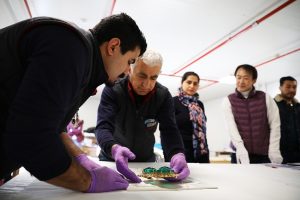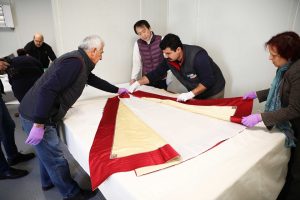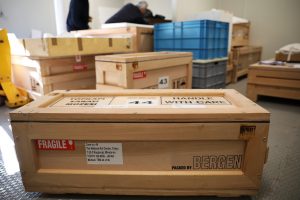ICEFAT is a global community of fine art shippers who operate at the very peak of our industry. Our agents pride themselves on offering the best services in their respective countries, with a comprehensive local knowledge allowing them to navigate the practical geography of their art scene as well as the laws and regulations surrounding their trade. There are countless logistical and regulatory complexities when moving a collection of priceless artifacts thousands of miles and two of our agents navigated this masterfully in a recent cross-continental project working together. Istanbul-based Bergen International Movers and Tokyo-based Yamato Global Logistics Japan worked together to transport a unique collection of historical artifacts from Turkey to Tokyo.

The 18th century ‘Sultan’s Throne Pendant’ with precious stones is carefully packed by the BERGEN fine art packers under the watchful eyes of the representatives of the Topkapi Palace and Tokyo museums.
To tell a story of the history and culture of Ottoman Turkey and the collections of its sybaritic sultans, two Japanese institutions, The National Art Center, in Tokyo, and The National Museum of Modern Art (MoMAK) in Kyoto, requested to loan historical objects from Turkey. In the largest single loan of Turkish objects ever agreed for an institution in the Far East, the Topkapi Palace Museum Dolmabahçe Palace Museum and Yildiz Palace Museum, loaned 185 museum objects. The Treasures and the Tradition of Lâle in the Ottoman Empire was scheduled, but first the objects had to get there.
Within this collection was a variety of pieces of varying size, weight, and complexity, and all being between 200 and 500 years old. From fine jewellery to delicate manuscripts, prayer carpets to palace furniture, tiles to ivory combs, utmost care was taken to packing each object. Altogether, the 185 items were packed into 54 bespoke crates for shipping.

The 17th century ‘caftan’ of the Ottoman Sultan had to be folded on specific allowed spots. After wrapping the ‘caftan’ in acid free paper, the ‘caftan’ is then placed in a prefabricated special box and secured inside the box to prevent any shifting movements.
Bergen’s art technicians carefully wrapped each object in acid free paper, before placing them in prepared Styrofoam-lined cartons. This packing was overseen by officials from the National Art Center in Japan. The packed cartons were then crated for airfreight and transported the short distance to the airport.
CITES licenses are required to export any object that contains material from endangered species – meaning objects containing elephant ivory required one. The complex application process for CITES licenses, nine were required in this instance, was smoothly handled by Bergen, ensuring there was no delay to the operation.

All the museum standard crates are fabricated according to the specifications / requirements of the Turkish Ministry of Culture. For the crate construction marine plywood with special wooden frames are used. The crates are designed for exhibition at multiple locations.
The packed objects for airfreight totalled 42 cubic metres, and were flown on a non-stop flight to Tokyo. Upon arrival in Japan, the cargo was picked up by Yamato who then transported the collection to the National Art Center. Condition checks again took place once the collection had arrived, to ensure that nothing had changed en route. Once satisfied, Yamato’s art technicians installed the works, including entire “showcase rooms” to house some of the objects. The objects were then transported once again to Kyoto, for the second and final stop of the exhibition.
The cooperation of ICEFAT agents enables an “in-house” service for whatever global fine art transport operation needs to take place. By fostering close relationships between fine art shippers all over the globe, seamless transportation of collections from across the world can take place with local knowledge almost anywhere the need arises.



